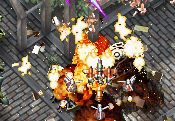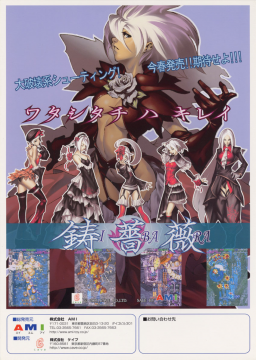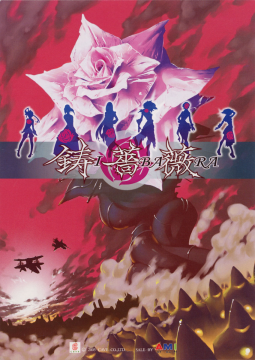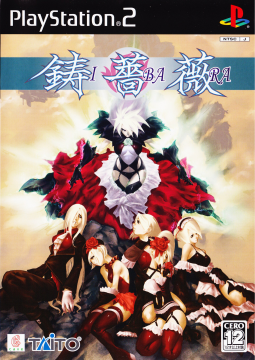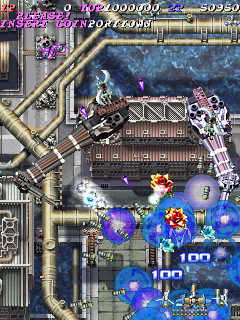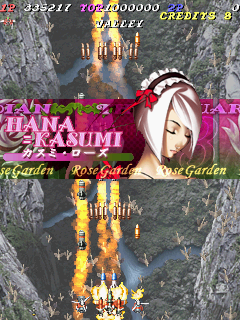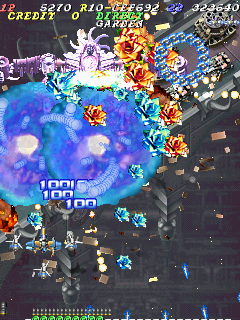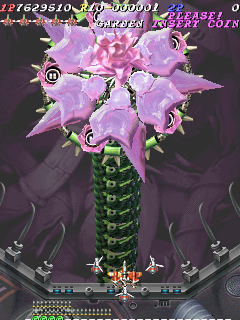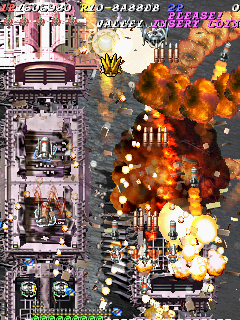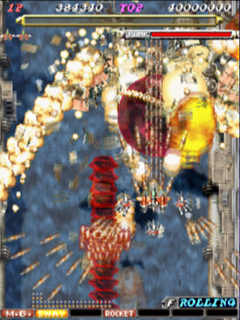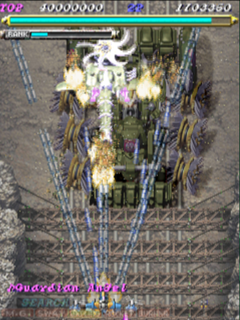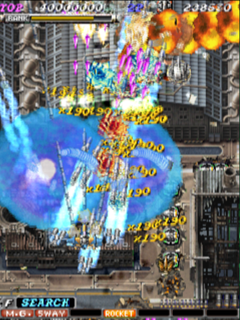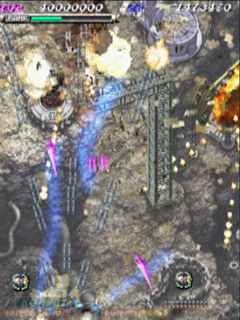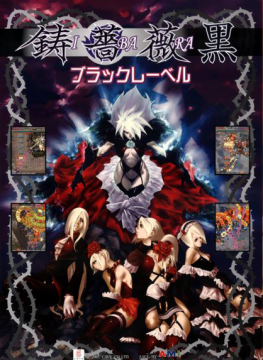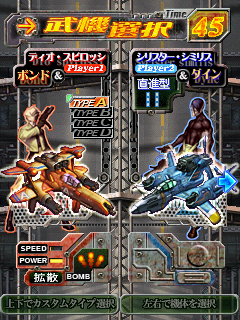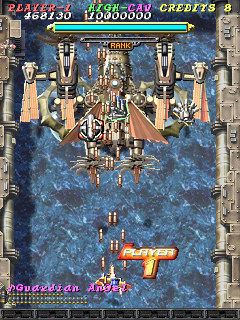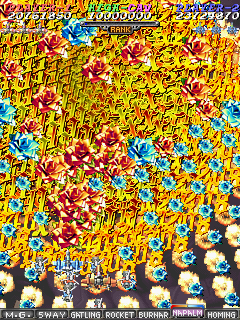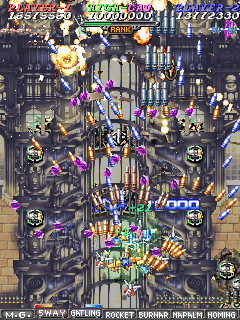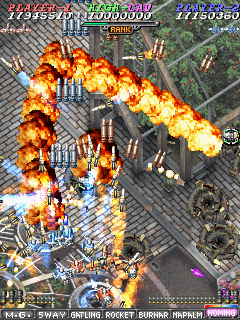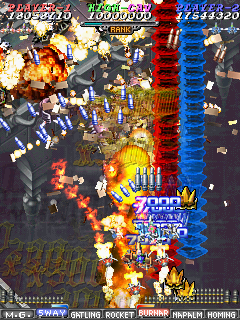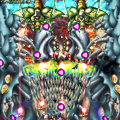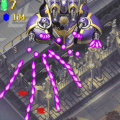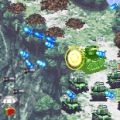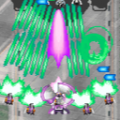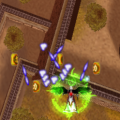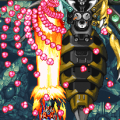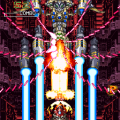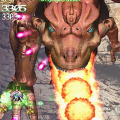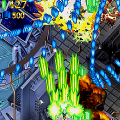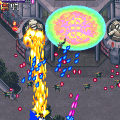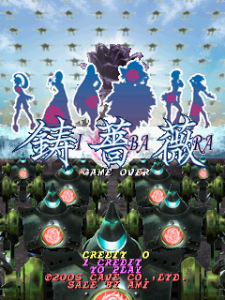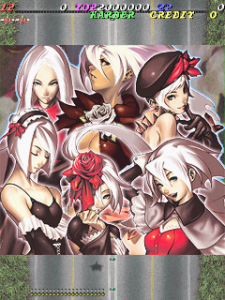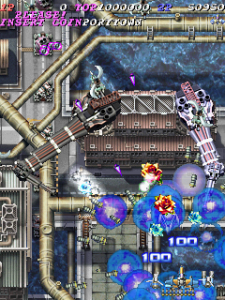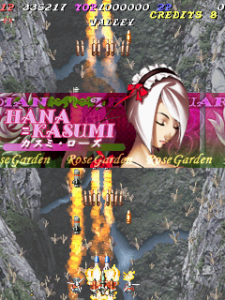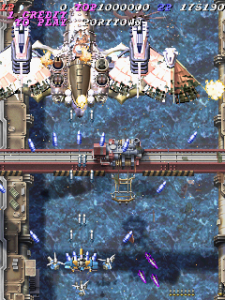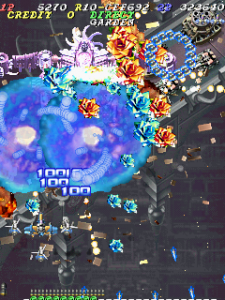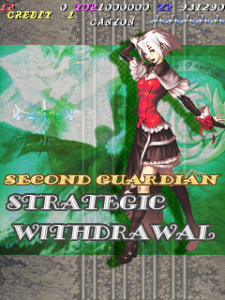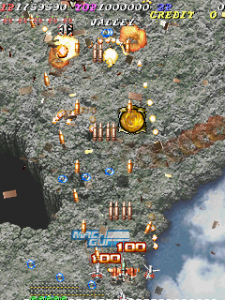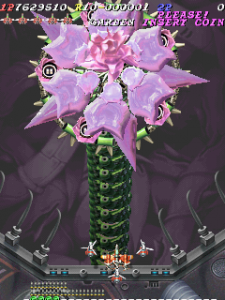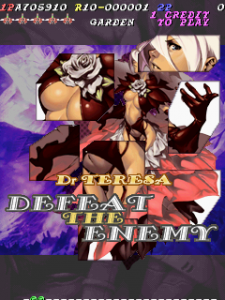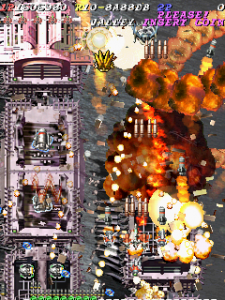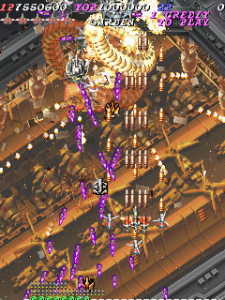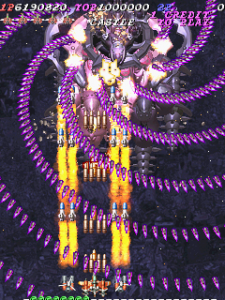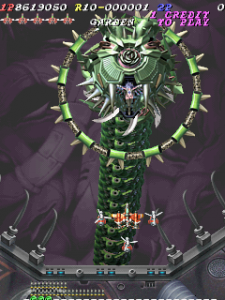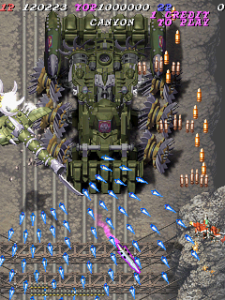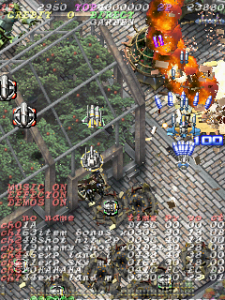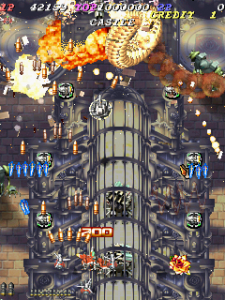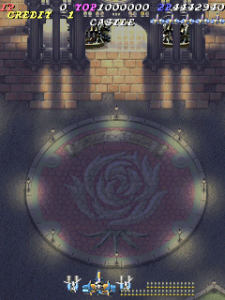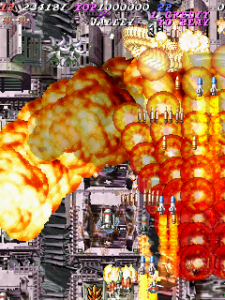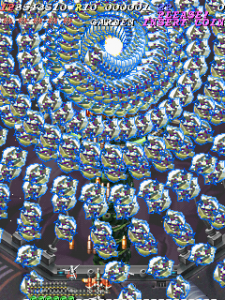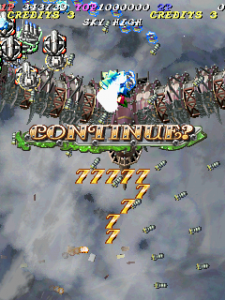Intro
Tsuneki Ikeda is known for defining the bullet hell shmup genre foundations, with Batsugun and DoDonPachi due to their screen filling bullet patterns and harder than hard difficulty, reaching previously unfathomable limits with Mushihime-sama and Cave’s new SH3 hardware. However, the reason why these games featured a ridiculous amount of bullets onscreen to utterly annihilate the player was due to Ikeda playing a game developed by Raizing in 1996 called Battle Garegga. Ikeda was floored at how fast they ramped up the difficulty, and could have 60 bullets on screen during certain boss phases. Ikeda, then thought “If they have 60 bullets, our’s will have 100! We won’t lose to them in terms of bullets.” The arcade version of DoDonPachi ended up having a max of 245 bullets onscreen.
In October of 2000, Raizing, developer of such shoot-em-ups as Mahou Daisakusen , Battle Garegga, and Armed Police Batrider was merged into another company, 8ing (Eighting), and the shoot-em-up division was dissolved. Around that time, the main programmer of Raizing’s shoot-em-ups, Shinobu Yagawa, was approached by Tsuneki Ikeda of Cave, with a simple request. “I want you to make Battle Garegga at Cave.” Yagawa accepted Ikeda’s offer, and on July 15, 2005, Cave released Ibara (lit. “thorns”) on Cave’s SH-3 hardware, a game that many consider to be the spiritual sequel to Battle Garegga.
Many players say that Ibara doesn’t feel like a Cave game, but that’s not entirely correct. What they really mean is that Ibara doesn’t feel like an Ikeda game, and for good reason. Yagawa has very different design philosophies and tastes than Ikeda when it comes to shoot-em-upa, and this is demonstrated in the games they made. Ikeda’s games featured lots of bullets, fast movement, strict chain-scoring systems, unforgiving difficulty, and severe punishment for using bombs or dying. Yagawa’s games tend be medal collectors, heavily rank-based difficulty system that gets harder the stronger the player is, employs an every-based extend system, a letter-based scoring system, destructible bosses, and are filled with scoring tricks and secrets. All of these and more were present in both Battle Garegga and Ibara, for better or worse.
Story
Ibara takes place in the 19th century, shortly after the development of the steam engine. Because of their precision crafting, the Northern European country of Edelweiss has excelled in the mechanical industry, and was achieving tremendous amounts of growth. However, dark clouds would soon rise up over Edelweiss’ horizon, as Professor Teresa Rose spoke to her 5 guardians with a fearless smile on her face. “Let’s destroy this filthy land and its people. We must make this world beautiful. Yes… then we’ll make the entire surface a lovely rose garden.” Teresa began her attack from their fortress, resembling a twisted and jagged mountain of knives. Under the Rose Garden Emblem, the nails of eerily laughing iron men destroyed buildings, the roars of planes covering the sky burn the Earth. The people’s cries and the rising flames illuminate the fortress, as if it were a beautiful flower blossoming from the scorched earth.
The Rose Garden’s power was horrific, but the Edelweiss forces pressed through the desperate battle. As the situation became increasingly dire, the Emperor ordered his Special Imperial Attack Unit, The Negotiators, into battle. “Annihilate the Rose Garden with your ships!” The Negotiators found that these “ships” had been secretly readied, as if predicting they would have to stand up to a threat and had longed for this day to come, shone bright.
Characters
Bond
The Player 1 character. Designated as Negotiator Agent 01. A man who doesn’t hide his feelings, but takes care of things sensibly on his own. Appears to have ties to the main antagonist, Teresa Rose. The gun-like objects in his hands are really the keys to his ship, Sirister Similus.
Dyne
The Player 2 character. Designated as Negotiator Agent 02. Always finishes his jobs in a cool, indifferent manor. He is not good at showing his emotions, yet seems to hold anger and outrage against the Rose Garden. Like Bond, the gun shaped object he holds is really the key for his ship, the Dio Spirossi.
Meidi Rose
The 1st Guardian of Mother Teresa, and commander of Rose Garden’s airborne units. The youngest of the sisters, optimistic and strong-willed. She is very close to Midi, often having competitions with her when destroying cities. Pilots the “Orange Meillandina” aircraft in battle.
Midi Rose
The 2nd Guardian of Mother Teresa, and commander of Rose Garden’s infantry. Midi is light-hearted and cheerful, but sometimes performs her duties rather poorly. She is very close to Meidi, often competing with her to see who can cause the most destruction. Commands the “Glorie de Midi” battle tank.
Kasumi Rose
The 3rd Guardian of Mother Teresa, in charge of weapons production. Kasumi does things at her own pace, and often tends to close herself off for brief periods of time. Kasumi also has a stubborn side, refusing to change weapon designs she’s grown fond of. Pilots the “Hana Kasumi” airship.
Shasta Rose
The 4th Guardian of Mother Teresa, in charge of information. Shasta is more stubborn than cheery, and is quite a fighter. Tends to act before thinking, but is incredibly bright, and very chatty. Pilot of the “Mount Shasta” aircraft.
Lace Rose
The 5th Guardian of Mother Teresa, in charge of strategic planning. Very quiet, and very cold-hearted. Follow Mother Teresa’s plans without question, burning countless cities to ash. In battle, she commands the subterranean mobile fortress “French Lace.”
Teresa Rose
The main antagonist and final boss of Ibara. At a young age, Professor Rose was the Head Engineer in the Edelweiss’ Empirical Artificial Limb Research Lab. She suddenly resigned after taking the blame for an accident, eventually falling off Edelweiss’ radar entirely. However, she has suddenly re-emerged with 5 other women, and commanded a legion of sharp mechanical soldiers. Rose Garden’s goal is to destroy the “filthy” land of Edelweiss and transform the surface into a “lovely rose garden.” Referred to as “Mother” by her 5 guardians.
Gameplay
In Ibara, players can select one of three different gameplay modes by holding the joystick in a certain direction when starting a game. If the joystick is being pressed down when start is pressed, the “Extended” mode of the game will be selected. Extended mode takes the player through two loops of the game, with the first loop being the regular game, and the second loop being a much harder version of the first loop. If the joystick is being pushed up while start is pressed, the game enters “Harder” mode, starting the player on the second loop difficulty of Extended mode. Otherwise, the game will play in the regular arcade mode. Each mode has its own individual high-score table. There is a hidden “Special Ver.” of the game, which allows players to learn more about the inner workings of the game mechanics, with extra information to be displayed during gameplay (similar to a debug mode). You can also select which stage to start on in this mode.
There are two playable ships in Ibara, but you might not know it if you only play by yourself. For some reason, Cave decided to have the ships be locked to a specific player, with Player 1 playing as Bond, and Player 2 playing as Dyne. This may not seem like much, but Bond and Dyne’s handle differently from each other. Bond’s ship is red, is moderately fast, and has a narrow shot type, while Dyne’s ship is blue, slower than Bond’s ship (in all variants), but uses a wide shot type…on their default selection mode. Players can have altered versions of their respective ships by holding down A, B, A and B buttons, or no buttons at all while pressing the Start button after putting a credit in. The combinations and results are shown in the following table:
Ship Variants | |||||
Type | Speed | Option | Shot | Bomb | |
Default (ST) | Normal | All fixable | 1P | Linear | Wide Napalm |
2P | Wide shot | Wide Napalm, slower than P1 ST, but lasts longer | |||
A | Slower | No fixable | 1P | Stronger ST shot | Linear napalm |
2P | Short range cluster in front | ||||
B | Faster | Side fixable | 1P | Penetrating Linear | Homing Twin Napalm |
2P | Concentrated P2 ST | Short range cluster bomb behind | |||
A + B | Fastest | Rear fixable | 1P | Wider ST shot | Area Blast Attack (Similar to Gain’s bomb in Battle Garegga) |
2P | |||||
Ibara is a two-button game consisting of an A (shot) and B (bomb) button. Pressing the A button will fire a shot, and holding it down has the effect of rapid fire, and also locks the player’s options in place. Players can increase their shot strength by collecting power ups. A hidden feature is that mashing on the A button really, really fast and then holding it has the possibility permanently increase the player’s shot speed for that life. (It won’t trigger unless the player hits the button so many times within x seconds, and it’s reset back to the normal if the player dies.) The B button releases smart bombs when pressed, but using bombs does not make the player invincible in Ibara. The amount and width of bombs released is based on the number of bomb fragments the player currently has, and the duration at which the bomb button is held. If the player does not have any bomb fragments, but does have a big bomb, pressing the B button will release 40 regular bombs. If the player has at least one big bomb, they can hold the B button for a few seconds to charge up the “Hado-cannon”, an incredibly powerful attack.
When charging the Hado-cannon, the player will gain a colored aura beam that goes a short distance in front of the player’s ship, damaging anything it touches. When the Hado-cannon is fired, it leaves a glowing red (or blue) trail in its wake, and creates a decently sized circular explosion for a few seconds upon contact with an enemy. Note that the trail does last longer than the explosions. Besides being incredibly powerful, both the Hado-cannon’s trail and contact explosion will convert enemy bullets into blue or red rose point items (depends on the bullet). This can be exploited on certain boss patterns for huge points!
Ibara has a unique options (the little helper pods on the left, right, and rear of the player’s ship) system, in which each option can be changed individually depending on what extremity the player’s ship touches it. Collecting an option that isn’t already equipped or powering up your shot will cause an aura flash, a very powerful miniature bomb around your ship. The options can be reset to their default position by pressing the Start button. There are a number of different option power-ups in Ibara: a 5 way spread shot; Burner, a long range flamethrower; Machine gun; Gatling, a faster version of the Machine gun; Homing Missiles, Napalm, a missile that creates a small explosion when it hits; and Rockets, which pierce through multiple enemies. The player’s main shot can be upgraded by collecting power-ups dropped from enemies. Both the shot power-ups and option power-ups have special versions that are picked up after allowing a certain number of specific power-ups to drop off the screen, and then picking up the next one that appears.
Similar to Yagawa’s previous titles with Raizing, there are two types of bombs – bomb fragments and big bombs. Bomb fragments are mainly dropped from ground enemies, or from destroying turrets on larger enemies. Collecting 40 bomb fragments will create one large bomb that can be used as a Hado-cannon. Players are also given 20 bombs (on default settings) after each death (during which, the player ironically unload bombs in every direction when destroyed).
The Beast Called Rank
Lastly, and arguably the most important aspect of gameplay is the game’s rank system. The rank system controls how aggressive the enemies are, their fire rate, number of shots to destroy enemies, enemy bullet speed and the number of bullets fired, and how fast items fall off the screen. Normally, this may not be a problem, but some of the later bosses become impossible to beat. Yes, impossible, their spreads become too dense and your hitbox is just too big to pass through. The ship’s hitbox is rather large, spanning the central section of the ship. This large size (compared to the tiny center spots in most Cave games) forces rank management to become even more important if you want to survive. Not to mention that there simply isn’t enough bombs in the game to survive a max rank boss onslaught (and they take upwards of 5 minutes to kill at maxed rank in later levels). It is possible to timeout each boss, (known as a strategic withdraw), but it’s really there for mercy, rather than a viable strategy. So, keep that rank low!
Unfortunately, managing rank isn’t easy, as simply having things like extra lives, bombs, a powered up ship, or even firing your shot increases the rank. This means that you’ll probably always be on your last life, starved for bombs, with a weak ship, avoiding as many enemies as possible…if you’re crazy. The game is about rank management, not trying to keep it permanently low. And since there is no on-screen indicator, players will need to instinctively know what their current rank is at all times. Rank is visible in Special Ver. as a line of @ signs at the bottom of the screen. Therefore, the key to triumphing over Ibara is to suicide your plane to forcibly reset the rank. In Ibara players are awarded an extra life every 1 million points, and while you do get an extra life, you’re probably going to suicide right after to reset the rank, because again, having extra lives causes the rank to drastically increase.
Scoring
If you plan on playing Ibara you’ll need to play for score. There really isn’t any other way around it. Suiciding resets the rank, and ships are awarded every 1 million points. There are four ways to get points in Ibara: collecting the blue and red roses that drop when bombing, collecting power-ups at max level, or options you already have on that side, shooting/destroying things, and medal chaining. As explained earlier, blue and red rose items are created when an enemy bullet comes into contact with the Hado-cannon, or a regular bomb. And while you obviously get points for shooting and destroying enemies, you can actually get more points by destroying enemies correctly. Some enemies, or even buildings, actually award extra points or medals if killed by a bomb or a Hado-cannon. Additionally, many of the bosses, and some of the larger enemies have multiple destructible parts that award extra points or other bonuses if destroyed. You really want to go for these destructible parts, as destroying them usually stops a part of the boss from firing, if not outright eliminating certain patterns.
Lastly, and most importantly, is chaining medals. Medals can appear from ground targets (large enemies, buildings) via bombs, or dropped from airborne enemies. The airborne enemies’ drops are set on a fixed pattern of shot power-up, medal, shot power-up, medal, option, medal, which repeats four times, then one pattern of shot power-up, medal, large shot power-up, at which point the cycle restarts at the first small shot power-up. At the start of the game, medals have a base value of 100 points. Collecting all medals on screen will cause the next wave of medals to increase in value by 100 points. At a value of 1,000 points, the medals increase by 1,000 points after each wave, maxing out at 10,000 points. This process is called “medal chaining” and will continue so long as the player is sure to catch the last medal of each wave on the screen. Missing the last medal will cause the process to start over, with medals reverting back to their initial value of 100 points. In order for the value to increase, the screen must be empty of all medals. Also, Ibara employs a ・letter score” system, just like Battle Garegga and Armed Police Batrider what this means is that after 9 million points, rather than receiving 10 million points, the millions digit becomes a capital “A”, and if all 26 uppercase letters are used, the game will then move onto lowercase letters. These scores are read as “(letter) million points”.
Music
The music in Ibara was composed by Shinji Hosoe, most famous for scoring classic Namco shooters like Dragon Spirit and Ordyne, as well as other titles like Ridge Racer, and more recently, 999: Nine Hours, Nine Persons, Nine Doors and its sequel, Zero Escape: Virtue’s Last Reward. Ibara‘s soundtrack is electro-rock, almost progressive rock. The opening track, “Show Time” is a great fast-tempo rock track complete with wailing guitars, and feels very Megaman X-like (which is a pretty good thing to be). All of the tracks really go well with their respective stage, with each having its own feel and rhythm without sounding out of place. It’s really well done! Interestingly, stages 1, 4, and 5 in Ibara have entirely different music when played on the second loop, with the Stage 1 (Round2) also being the staff roll music. Altogether there are 20 tracks, with the normal 15 songs used in the game, 1 unused track, 3 arranged tracks, with the final tracking being a voice collection from the game. The official soundtrack came with a figure of Dr. Teresa Rose.
PlayStation 2 Port
Starting in 2003, Cave would port a total of four of their flagship arcade titles to the PlayStation 2. Two of these ports were from their pre-SH-3 hardware titles, DoDonPachi DaiOuJou and Espgaluda, and the other two ports were the only two shoot-em-ups that ran on the SH-3 hardware (at the time): Mushihime-sama and Ibara. The pre SH-3 titles were ported and published by Akira, and the games released on the new SH-3 hardware were ported by Cave and published by Taito. The Akira ports were really good, nearly arcade perfect, even featuring the same 15khz 240p graphical output as the original arcade versions. The Cave/Taito ports on the other hand, are graphically inferior, poorly optimized versions of their arcade counterparts.
Features
The game features an Arcade mode, a Practice mode for the Arcade mode, an exclusive Arrange mode, and a gallery containing 78 pieces of promotional and concept art of the game. There is also an options menu, where players can change their button configurations, save or load their data, and have their display in Yoko (horizontal) or Tate (vertical) mode. Yoko mode causes there to be wasted space on the left and right sides of the screen, but these can be filled through a small selection of wallpapers. It’s not much, but it’s nice to see them trying to do something with the space. Tate mode is how the game is played in arcades, filling the screen and leaving no wasted space.
The Arcade Mode, plays just like is arcade original, with a few changes in how to start the game. In the arcade version, you could select different modes and ship variants depending on the buttons and joystick directions held when pressing Start. However, this is no longer possible with the PlayStation 2, so the ship variants can be setup before you start via the configuration menu option, and players can choose which of the three modes to play before actually starting the game. Interestingly, Bond and Dyne are still locked to the Player 1 & Player 2 sides, meaning that to play as Dyne; the player would need to start the game with their controller in the Player 2 port. Practice mode, something not present in the Mushihimesama port. The practice mode is rather simplistic, only allowing players to play any of the game’s 6 stages, from the beginning (or “top” as they call it) or at the boss. If a player loses all their lives, they receive a Game Over and are sent back to the menu, as there are no continues in Arrange mode.
Arrange Mode and Scoring
The PlayStation 2 port of Ibara also included a new Arrange mode, changing many aspects of the original game, and adding new systems to create a more “Cave-like” version of Ibara. Arguably the most important addition is a bar in the top right (if Player 1) or top left (Player 2) of the screen that displays the player’s current rank, which now increases and decreases at a much faster rate. Collecting power-ups, bombs, sub-weapons, and now medals will increase the rank. The amount of rank that medals add is proportional to their value, with 100 points adding zero rank, and the 10,000 point medals adding around 10-15% of a bar! Luckily, collecting rose items decrease the rank, and of course, dying will reset the rank to zero. Another change in Arrange mode is a completely overhauled option system.
The first change is that all sub weapons are can be cycled through once collected via the press of a button, and fire from all three options (which are acquired once a sub weapon is picked up). Players can also cycle through the options’ formations, the order of which is: Normal, Back, Wide, Rolling, and Search; pressing the button again will switch the formation to Normal, restarting the cycle. There is a bar at the bottom of the screen that keeps track of the player’s collected sub weapons and current option formation. The Player’s hitbox has also been reduced to a smaller Cave size hitbox. Holding down the shot button will cause your ship to fire as fast as possible, maximizing firepower by leaving no gaps in between the bullets, but at the cost of reduced movement speed. This mechanic is featured in most Cave games, and is used primarily on bosses (who now have lifebars), where the reduced movement speed allows for more precise dodging of the boss’ bullet patterns. When the player loses a life, they now receive a full bomb, rather than the usual 20 bomb fragments. Extends are now set at every 10 million points, up from the previous 1 million points in the original Ibara. Extends are now more important than ever, as players cannot continue from a game over in this mode.
Scoring in Arrange mode is centered around a new rank-based multiplier that is applied to the red and blue rose items created when via canceling bullets with bombs or by destroying certain enemies. At max rank, the rose items are worth 300 times their normal value! Therefore, Players will want to get max rank as quickly as possible, and then cash in their x 300 multiplier by bombing a big pattern. However, collecting rose items will quickly lower your rank, starting the cycle over. Medal chaining still exists in Arrange mode, and remains an important aspect in scoring, not because of their score value, but rather the large amounts of rank increase when collecting high value medals.
High scoring in Arrange mode is really all about having a high or maximum rank, and therefore a high multiplier. Even if players bomb a bad pattern, causing very few rose items to be created, that’s ok, because their rank won’t decrease as much as it would on a dense pattern, making it easier to get a high multiplier again. Bombing dense patterns with zero/low rank is worthless due to the x1 multiplier, in addition to wasting both a bomb and a future bombing opportunity, and should therefore be avoided whenever possible.
Issues With The Port
This port is a perfectly playable version of Ibara, but when compared to its arcade source, it’s the worst of all of Cave’s ported titles. Developers counter this by forcing the game to slow down through various means, giving the players just enough time to make the difference between life or death. This life-saving slowdown is completely removed in the PlayStation 2 port of Ibara. Perhaps they wanted the game to be fast? That would also explain the next issue. Take a moment at look at the Ibara PlayStation 2 images, please click on them and really get a good look at them. For some reason Taito put this forced blurry filter on the Ibara and Mushihime-sama PlayStation 2 ports, and you can’t turn it off. The Ibara port is also plagued with rather lengthy loading screens. One last thing of note is that for some reason they censored Dr. Rose’s promotional art for the PlayStation 2, painting her previously exposed chest white, and it looks very out of place compared to the rest of her outfit and design.
Is The Port Worth Playing?
If you love Battle Garegga, or Yagawa’s games, then this would be worth looking into. The new Cave-like Arrange mode is pretty fun, and the game does include a practice mode for the arcade version, even if it is missing the slowdown. Just expect to pay a premium due to its rarity and Japan-only release.
Final Thoughts
Players were right when they said that Ibara doesn’t feel like a Cave game. It has a brutal difficulty, but in completely different ways than Cave’s usual style. This drastic tonal shift really turned off a number of players. Ibara plays like Raizing games did back in the late 1990s, but Ibara was released in 2005, to a different audience. If you like Battle Garegga and Yagawa’s games, then you’ll feel right at home with Ibara. But for the players who aren’t familiar with Yagawa’s style, the game’s high learning curve, unforgiving rank system, forcing the player to play for score to just survive, may be too daunting a task to overcome. There is fun to be had in Ibara, but the game will do everything it can to cut it short for the player.
Links:
The Lunatic Ibara Scans from “The Lunatic Ibara” Superplay DVD, very detailed…in Japanese
Shmuplations Superplayer Interviews A collection of player interviews from the official DVD
Ibara Arrange strategy thread from shmups.system11.org A great resource for learning about the game
Ibara Arrange mode Superplay a replay of a 140 million point run on YouTube
Ibara Kuro: Black Label (鋳薔薇 黒: ブラックレーベル) – Arcade (May, 2006)
As Cave was working on the Arrange version of Ibara for the PlayStation 2 port, someone suggested that it could well in the arcades, with some additional tweaking, of course. So Mamoru Furukawa, the programmer for the Arrange mode, adjusted the game again, completing what would be known as Ibara Kuro: Black Label. The game would see a very limited release at just 100 PCBs in May of 2006. The PlayStation 2 Arrange mode should be seen as the predecessor to Ibara Kuro: Black Label, that said, Ibara Kuro: Black Label is fundamentally different than Arrange mode, and should be treated as such.
Changes and Gameplay
Gameplay in Ibara Kuro: Black Label is the closer to the Arrange mode found in the PlayStation 2 port of Ibara than the original version of the game. Like Arrange mode, players are able to switch weapons by pressing a button, although the ability to change the options formation has been removed. The rank bar is also now in the center of the screen. The controls are roughly the same as the original, with the addition of a button dedicated to rapid fire of the normal shot. Holding down the A button causes the player’s ship to slow down, in addition to increasing its fire rate and making the ship’s hitbox visible. Ibara Kuro: Black Label adds two important changes to the player’s ships.
The first change is that the Silister Similis (Bond’s ship) and Dio Spirossi (Dyne’s ship) are no longer locked to the Player 1 and Player 2 sides, with both ships being selectable at the start of the game. After selecting your ship, players then select their ship type. The different ship types are the same as the ones previously only selectable by holding down certain button combinations when selecting your ship. They are listed in the game as A Type (default version), B Type (A button held ship), C Type (B button held variant), and D Type (variant selected by holding A + B). Each ship variant also has its speed, power, and bomb information displayed for that type when highlighted. Note that while both ships are selectable for either player, the characters themselves are still locked to their respective sides. The second change, is that any time the A button is not being held down, any nearby medals, power-ups, or other collectible items are sucked into your ship. This is a game-changer, making the game quite a bit easier than the regular Ibara, but also makes the game tons more fun, as you don’t have to put your life on the line when trying to keep the medal chain going. The Dio Spirossi ship (the wide shot ship) can suck in items further away than the Silister Similis can.
Scoring in Ibara Kuro: Black Label is comprised of three systems that work together: the Baradise system, the XTC system, and medal chaining. In the PlayStation 2 Arrange mode, there was a previously unnamed multiplier system involving the value of the rank bar and the rose point items. That system makes a return in Ibara Kuro: Black Label as the Baradise system. The Baradise system was the key component for scoring big points in the PlayStation 2 Arrange mode, but now, it is mainly used for clearing the screen of bullets or manually reducing rank, as it only offers a moderate amount of points when used by itself. Also, on bosses, successfully clearing a phase (doing enough damage or timing them out) will automatically trigger Baradise for all bullets on screen.
Medal chaining is the same as it was in the original Ibara, so please refer to that entry for more details. The last system, the XTC system stands for “Xtreme Terror Counter”, and is new for Ibara Kuro: Black Label. When holding down the A button, a ring will appear around your ship, along with a number located a little bit above and to the right of your ship. This system acts like the “scratching” systems found in Touhou and other doujin danmaku. Whenever an enemy bullet passes through the ring, the bullet’s normal value is added to the value of the XTC, in addition to increasing the XTC itself. The XTC can be increased up to a maximum of +9999. Letting go of the A button will cause the XTC to fade away, in a few seconds, once it’s completely faded away, you have about one second to have another bullet pass through it or the XTC is reverted back to +0.
Scoring
As stated earlier, scoring in Ibara Kuro: Black Label consists of three main scoring systems: the Baradise System, the XTC system, and medal chaining. Here’s how these three systems work together. First, to get the most use from the Baradise system, you will need to max out the rank. This is most easily accomplished by collecting the 10,000 point medals from medal chaining. To get big points from the XTC, it needs to be used in conjunction with the Baradise system. Whenever a large enemy or boss phase is defeated, the value of the XTC is combined with the Baradise’s multiplier, resulting in huge points. Normally, whenever a player bombs and cashes in their Baradise multiplier, their XTC is reset to zero, making it only profitable to cash in on this multiplier during boss fights or during a specific section of the first two stages. It’s actually better to keep building or maintain a high XTC for stage 3 onwards, as you end up getting more points from just keeping a high XTC then cashing it in outside of the boss.
The best sub weapon to use when milking enemies for XTC is the machine gun, or the Gatling gun on bosses. Normally, the XTC is reset to zero whenever the player dies, however, if the player starts shooting with the held-down A button immediately after their death, and is close enough to enemy fire, it is possible to retain the XTC’s value and keep building it up. A basic pattern for getting good scores is build up your XTC throughout the level (which is increasing your score the entire time), and get max rank before (and have it during) the stage’s end boss. Then, destroy a phase of the boss where there are tons of bullets on screen, and then milk the boss for as much XTC as you can, cashing it in when you destroy the next boss phase. If players need to increase their rank during the boss fight, using the Hado-cannon will usually completely max out the rank if it hits, but it also severely damages the boss and costs a bomb to use.
Final Thoughts
It’s a shame this title had such a limited release, as it’s actually a really fun game. With the different ships and ship types, there’s a total of 8 possible combinations, each with its own firing type, movement speed, and bomb pattern. And as if that weren’t enough, players can switch between a total of seven different subweapons whenever they want, and the new ability to suck in nearby items when not shooting gives the player lots of freedom in how they want to play the game. Ibara Kuro: Black Label is also a rather interesting game, not quite a Yagawa game, but not quite a Cave game either, instead existing as a beautiful mashup of the two styles, resulting in a wonderfully unique game.
Links:
STG Weekly #38 A highly insightful look at Ibara, contains NSFW language
Ibara strategy thread from shmups.system11.org A great resource for learning about the game
Ibara Arcade Mode Options Details on how to unlock the Special Ver. on the PCB
Translated Interview at Shmuplation A great interview with designer Akira Wakabayashi
Translated Interview at Gamengai A different interview with Shinobu Yagawa and Akira Wakabayashi
Ibara OST Playlist A YouTube playlist of the Ibara OST
Ibara Kuro: Black Label basics A brief overview and scoring tips from shmups.system11.org’s forums
